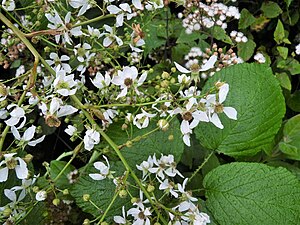La Palma blackberry
| La Palma blackberry | ||||||||||||
|---|---|---|---|---|---|---|---|---|---|---|---|---|

La Palma blackberry ( Rubus palmensis ) |
||||||||||||
| Systematics | ||||||||||||
|
||||||||||||
| Scientific name | ||||||||||||
| Rubus palmensis | ||||||||||||
| A. Hansen |
The La Palma blackberry ( Rubus palmensis ) is a plant type of the genus Rubus in the family of the rose family (Rosaceae). Their range is limited to the western Canary Islands .
features
The La Palma blackberry is a perennial pseudo-shrub that, as a spreading climber, reaches a height of up to 5 meters. The growth is overhanging, the plants are evergreen. The light green, up to 2.5 centimeters thick shoot axes are usually covered with dense and long glandular bristles. The spines are slightly inclined, straight or slightly curved.
The palmate, divided leaves are 5-fold. The individual leaflets are broadly ovate to broadly elliptical and have a thin tip . The blade of the long-stalked terminal leaflet is almost rounded with a heart-shaped base and between 8 and 20 centimeters long, the lateral and lower leaflets are shorter and smaller. The stalks of the leaflets and the petiole itself are covered with very dense curved spines that act as climbing organs. The leaf tops are green and slightly wrinkled, the leaf undersides are pale green in the shade, but gray-white in sunny locations by tiny, dense star hairs. The edges of the leaflets are finely serrated.
The up to 40 centimeters wide, conical inflorescences are glandless and only have a few short spines. The hermaphrodite flowers are up to 4 centimeters in size. The sepals are green. The 5 white petals are elliptical. The La Palma blackberry blooms from the end of April to June.
The number of chromosomes is 2n = 28.
Distribution and locations
The La Palma blackberry is endemic to the Canary Islands and has been detected there from La Palma , La Gomera , Tenerife and Gran Canaria . It grows in humid stream valleys and gorges as well as in clearings of the laurel forest at altitudes between 300 and 1,200 meters above sea level.
Similar species
The La Palma blackberry can be confused with the large-leaved Bolles blackberry ( Rubus bollei Focke) that grows in the laurel forest level of the Canaries . It differs from this, however, by the shoots covered with long glandular bristles and the non-leathery leaves.
Systematics
The La Palma blackberry was described in 1972 by the Danish botanist Alfred Hansen . The holotype has no differentiated leaves, but rather young leaves with an atypical end-leaf shape. Hansen still referred to the species as endemic to La Palma, but it has also been found in the other western Canary Islands, where it used to be either indefinite or confused.
The La Palma blackberry is placed in the Grandifolii Focke series within the section and subgenus Rubus .
literature
- A. Marrero, J. Caujapé-Castell & J. Naranjo Suárez: Rubus palmensis A. Hansen (Rosaceae), nueva cita para la flora vascular del Parque Nacional Garajonay en la Gomera, Islas Canarias . Botánica Macaronésica 28, pp. 159–164, 2013.
- W. Nezadal, R. Lindacher & W. Welss: Local endings and phytodiversity of the western Canary Islands La Palma and La Gomera . Feddes Repertorium 110, pp. 19-30, 1999.
Individual evidence
- ^ G. Matzke-Hajek & HE Weber: A survey of the Rubus species (Rosaceae) described from the Canary Islands . Anal Jard. Bot. Madrid 57, pp. 25-35, 1999 online
- ↑ Michal Sochor: Diversity, phylogenesis and evolutionary mechanisms in the genus Rubus . PhD. thesis, Department of Botany, Faculty of Science, Palacky University, 119 pp., 2016
- ^ A. Hansen: A new Rubus species from the Canary Islands . Bot. Notiser 125, pp. 379-382, 1972

